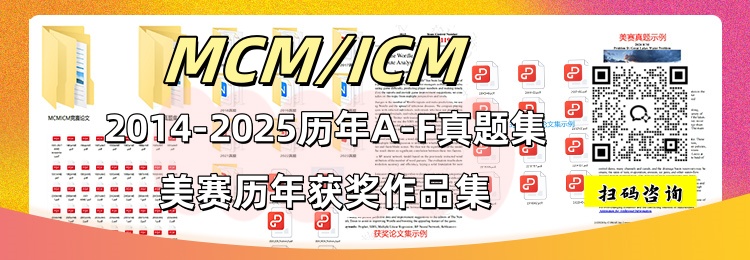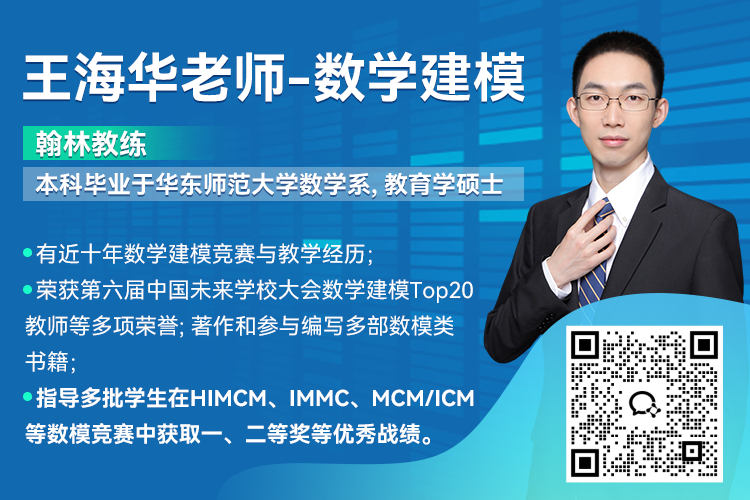MCM:数学建模竞赛
ICM:跨学科建模竞赛
2025 MCM/ICM 问题
MCM 问题
MCM 问题 A:测试时间:楼梯的持续磨损
MCM 问题 B:管理可持续旅游业
MCM 问题 C:奥运奖牌榜模型
问题 C 数据.zip
ICM 问题
ICM 问题 D:更美好城市路线图
问题 D Data.zip
ICM 问题 E:为农业腾出空间
ICM 问题 F:网络强大吗?
2025 年MCM A 题结果
MCM(A)题的五位杰出获奖者是:
中国南京邮电大学 2500836
2501567 中国浙江大学 - 美国数学学会奖
2501909 中国南京邮电大学 - 本·富萨罗奖
2504218 中国哈尔滨工业大学(威海) - 运筹学与管理科学学会奖
2511565 复旦大学,中国 - 美国数学及其应用联合会奖学金奖及工业与应用数学学会奖
2025 年MCM B 题结果
MCM(B)题的七位杰出获奖者是:
2501687 北京大学,中国 - COMAP 奖学金奖
2502617 中国中央财经大学 - 运筹学与管理科学学会奖
2503268 中国上海科技大学 - 美国数学学会奖
美国德克萨斯州休斯敦市莱斯大学 - 美国数学协会奖 2504448
中国南京理工大学 250519
2509557 中国浙江大学 - 美国工业与应用数学学会奖
中国北京科技大学 2517929
2025 年MCM
问题 C 结果
MCM(C)问题的十八位杰出获奖者是:
中国安徽师范大学 2500759 号
中国暨南大学 2501869 号
中国四川大学 2503389
中国南京理工大学 2505964
中国三峡大学,中国 2507817
中国南方科技大学 2510006
中国重庆大学 2510185
2510862 东北财经大学,中国 - 美国数学学会奖和工业与应用数学学会奖
2513314 中国西安交通大学 - COMAP 奖学金奖
2514362 中国国防科技大学 - ASA 奖
中国上海交通大学 2514461
中国东北大学 2515235 号
2516178 中国厦门大学
中国石油大学(北京)克拉玛依校区,中国 2516695
中国郑州大学 2517690
中国西安交通大学 2521556
2522820 美国纽约州史岱文森高中 - 美国数学协会奖
中国南京农业大学 2524070
2025 年 ICM
问题 D 结果
国际数学建模竞赛(D)题的四位杰出获奖者是:
2504188 中国南京邮电大学 - 运筹学与管理科学学会奖
2507692 北京师范大学-香港浸会大学联合国际学院,中国 - 美国数学学会奖
2516219 中国国防科技大学 - 美国数学及其应用联合会奖学金奖及美国工业与应用数学学会奖
2519935 中国杭州电子科技大学 - 莱昂哈德·欧拉奖
2025 年ICM
问题 E 结果
国际数学建模挑战赛(E 题)的四位杰出获奖者是:
2502355 中国武汉大学 - 运筹学与管理科学学会奖
2508861 中国劳动关系学院,中国 - 美国工业与应用数学学会奖
2515136 电子科技大学,中国 - 美国数学及其应用联合会奖学金奖及蕾切尔·卡森奖
2517273 中国华南农业大学 - 美国数学学会奖
2025 年ICM
问题 F 结果
国际数学建模竞赛(F)题的五位杰出获奖者是:
2504223 中国西安理工大学 - 美国数学学会奖
2507789 电子科技大学,中国 - 美国数学及其应用联合会奖学金奖及维尔弗雷多·帕累托奖
2513705 中国北京师范大学 - 运筹学与管理科学学会奖
2517199 电子科技大学,中国
2521039 中国农业大学,中国 - 美国工业与应用数学学会奖
备赛的同学可扫码咨询领取
【2014-2025美赛历年真题集+MCM/ICM历年获奖论文集】⇓










